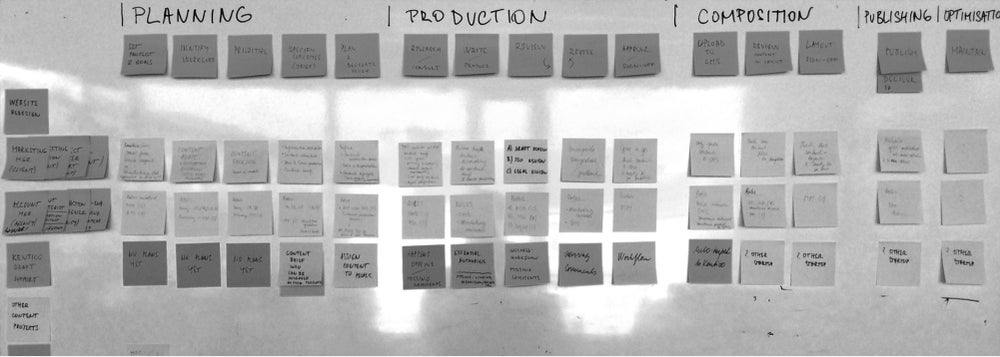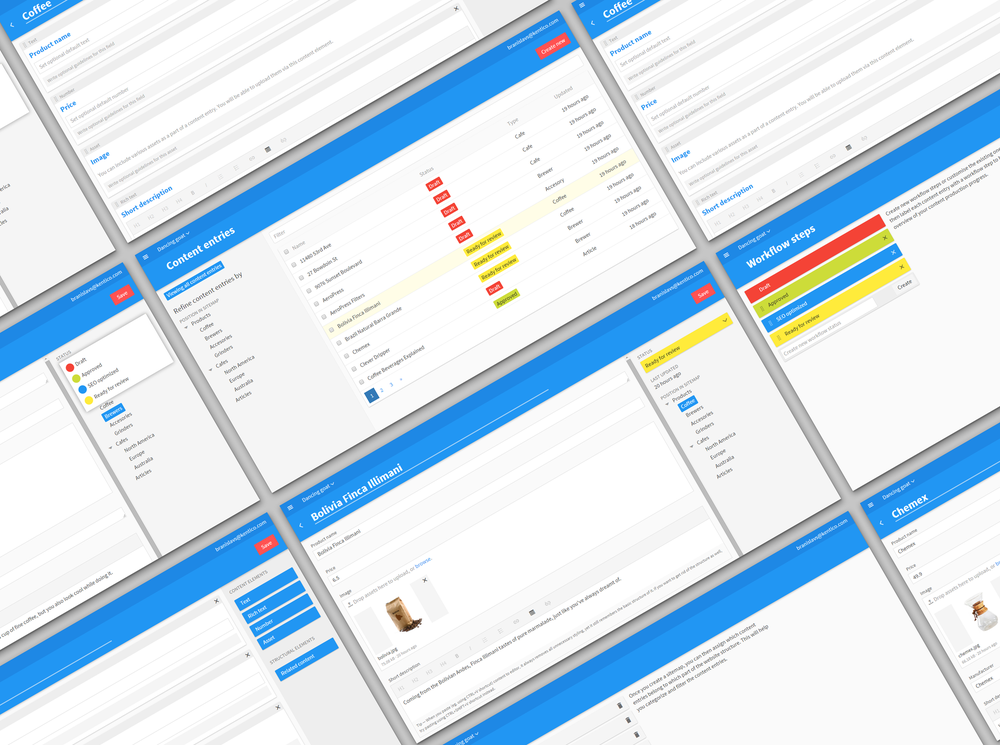Kentico Kontent:
Designing a global
B2B SaaS from 0 to 1
Challenge
Kentico desired to expand its content management service as a cloud offering. After one failed attempt, the top management was finding other ways to build a cloud service. They pulled together an internal startup team to bring in a new business.
Contribution
As a founding team member, I brought Kentico Kontent from an abstract idea (2015) to its scaling (2019). I was sitting on many chairs throughout the project to kick the product out of the door and make it successful: I validated early product ideas, built a beta version, launched an MVP, and scaled the product to a million-dollar business.
Kentico Kontent is now a leading headless CMS to manage digital content across multiple platforms, technologies, and devices. It’s the heart of the modern content strategy, serving B2B customers around the globe.
The birth of an internal startup
Kentico CEO had a vision that digital content will be managed in the cloud. He made an intuitive decision to take traditional CMS and wrap it as a cloud offering. In 2015, after four years of development, the project was shut down. A lot of time and money was wasted, but it was a key learning experience.
The failed project paved a path for a new initiative. At the company, we still believed that managing digital content in the cloud is the future; it’s only that the intuitive approach didn’t work out. A traditional CMS wrapped as a cloud offering was driven as a technological feast. It lacked insight on what problem it should solve and for whom. Even though the team was working around the clock to find its place in the market, it could not get sufficient traction and a marketable segment.
After learning a costly lesson, the CEO decided to restart the cloud initiative and do things differently this time. He decided to put together “an internal startup team”; an independent team with essential company support. All employees voted who should be the good fit for the challenge, and that’s how I—as the only product designer—got into the team of five.
We started in early 2015, and our goal was to find a subscription-based business that would benefit from the company’s expertise in content management. As an autonomous team, we had only two limitations:
- whatever we do, we should be ready to launch it at Kentico’s annual conference in October 2015,
- we shouldn’t threaten the current business.
We had eight months to build a product. We could build anything, and the challenge was to find the right path.
Stage 1:
Validating product ideas
We’ve started our journey with a bold, broad and naive idea. We thought we’re going to solve all content production problems of all marketing teams. After two months of research and talking to customers, we narrowed down our focus on solving web project delays for digital agencies.
Here are the methods that helped us the most in pivoting towards a meaningful business plan.
10+ Lean Canvas iterations
We kicked off team discussions by fleshing out Lean Canvases of businesses that each of us envisioned. It was a marvelous calibration exercise that opened up a discussion about individual expectations-how everyone on a team thinks about a business, about customers, about a solution.
Lean Canvas brought us on the same page on what problem we’d like to solve. Of course, the initial plan was overly optimistic and unrealistic. But as we were aligned on where we want to go, we iterated towards the better-sounding business plan. Lean Canvas served as a compass along the validation path.

My first Lean Canvas sketch, one of many. It’s messy, and that’s ok. Rather than holding onto an idea in my head, I prefer to discuss early concepts on a paper. Ideas may sound right in our minds, and the fastest test is to write them down.
Jobs-to-be-done mapping
Desk research, hand in hand with customer interviews, helped us narrow the scope of the problem we wanted to solve.
We reviewed a ton of businesses in the content management space. We sifted through countless white papers and listened to content thought leaders. We wanted to grasp where the world of digital content production is going and how we can fit in.

We explored the digital content landscape far and wide. There were a lot of promising paths we could take. How do you choose the one?
I vividly remember how one day it just occurred to me to sort the competition by their core jobs-to-be-done. And then we saw it.
There was an underserved entry market where we could start without fear of cannibalizing Kentico’s other product. On top of that, this entry point would still leave us a couple of options. We could either grow in that market or transition to the bigger market with a competitive advantage later. It was a strategic starting position.
50+ remote customer interviews
There is no better reality check than talking to prospects. We have done more than 50 remote customer interviews across the globe to identify content problems worth solving and to validate a solution’s scope and value.
We’ve done interviews in batches. First, focused interviews on understanding and identifying painful problems. Once we were confident about the problem we wished to solve, we’ve moved on to concept walkthroughs to nail the solution.
I’ve done a research design for those interviews, as well as conducted the majority of interviews. It was a lot of work, and luckily enough, few developers in a team were also excited to talk to customers. I’ve mentored them to lead the interviews, and they’re excellent product managers today.
Sketching & wireframing
I did a couple of iterations of various fidelity prototypes to have an early productive conversation with the team, stakeholders, and prospective customers.
I’ve also used prototypes to talk to myself. As we were heading towards managing structured content, we needed to understand what it will take to structure complex content-heavy projects in our tool. As much as we’d like to test it, we would need to pull in content strategists, designers, and developers together to see the pitfalls of our early concepts. However, this was not feasible at the time. So I’ve decided to test-drive our early prototypes the other way. I have downloaded dozens of content-heavy web pages representing popular content types such as case studies or product feature pages. I’ve outlined the structure of these content types and role-played how such content could be modeled and created in our tool. The role-play has uncovered many conceptual flaws in our assumptions and helped us design a better product at the fundamental level.

Sketching is an integral part of my process. Most of my thoughts start on paper. Paper is cheap and dispensable. It invites you to draw as many ideas as you can. It encourages you to throw bad ones right away. Paper reflects immediate thoughts so you can build on top of them. It’s a communication tool inviting others to build something worthwhile. I’ve done hundreds of sketches at this stage and hundreds more later.

Paper sketches eventually become wireframes of concepts we tested with prospects.
Stage 2:
Building an MVP
After two months of research, we were confident and aligned on what problem we want to solve (web project delays) and on who our early adopters are (digital agencies). We still had hypotheses to validate, but with 6 months left, we were transitioning our efforts towards development.
Even as a small team, we were disciplined in prioritizing and planning bi-weekly sprints to focus on launching a desirable product in October.
Here are the tidbits of our journey towards a worldwide launch.
Scoping an MVP
Deciding on what features should be in MVP can be a tough exercise. Since we’ve done solid research, scoping was relatively easy for us.
We understood the overall content production process and how our solution fits in. Instead of “thinking about features”, we thought about the minimum job we need to support to make our service valuable. And only then, we mapped features that were relevant to that minimum job.

A whiteboard with sticky notes of customer jobs, roles, and activities.
Visual design
Being also a visual designer, I had a rare opportunity to bring a bespoke visual style to a brand-new product. But as I was also sitting on the product manager’s chair, I knew there is no time for bespoke visuals if we wanted to launch in October. I made a strategic decision to base our product on Google’s Material design guidelines and focus on shipping the product, tending to beta customers, or testing the sales script.
Eventually, we updated look&feel of the product once we demonstrated the business viability.

The early visual style of the product was based on Google’s Material design to speed up time to market.
Worldwide launch
We had a unique launch position as an internal startup in the global company. In October 2015, Kentico held company conferences in three places worldwide—in Australia, the U.S., and the Czechia. My role was to prepare and deliver the part of the keynote speech introducing the new product.
The product caught instant attention, and we established a lot of relationships with future customers.
Scaling the business
After launching in October 2015, we were in the loop of getting new customers, listening to their feedback, and improving the product.
Before I left the company in 2019, we scaled from five people to 50+ talented employees working on the product that was generating seven-digit ARR.
Kentico Kontent is now a leading headless CMS to manage digital content across multiple platforms, technologies, and devices. It’s the heart of the modern content strategy, serving B2B customers around the globe.
Kudos
I’ve done a great deal of work on this project in the early stage, but none of that would happen without the core team of extraordinary people—Tomáš Hrubý, Vilém Jeniš, and Roman Mazur.
Also, I’ve always admired Petr’s (Kentico’s CEO) faith in our abilities. His trust enabled us to make something remarkable.
I work with people, startups, and software companies to:
- validate product ideas,
- conduct customer research,
- set scalable product strategy,
- design digital products.
Let’s do a project, a workshop, or mentoring.
Hire me at hi@brano.me.